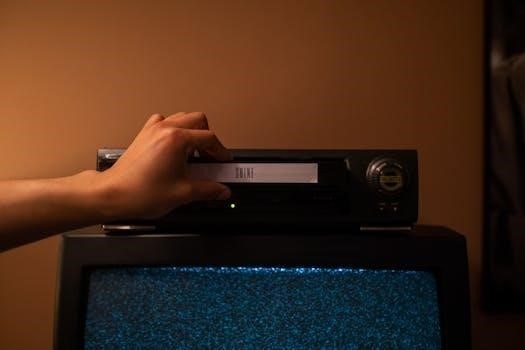FPD-7024 Overview
The Bosch FPD-7024 Fire Alarm Control Panel is a fully integrated, hard-wired fire alarm system. It is designed for reliability and ease of use. The manual set offers comprehensive details on its features, installation, and operation. Free use; no registration is needed.
Key Features of the FPD-7024
The Bosch FPD-7024 Fire Alarm Control Panel boasts several key features that make it a reliable and effective solution for fire detection and alarm systems. Its fully integrated hard-wire design ensures robust and dependable performance. The system’s comprehensive manual provides detailed instructions for installation, operation, and maintenance, ensuring users can effectively utilize its capabilities.
The FPD-7024 supports a wide range of fire detection devices, including smoke detectors, heat detectors, and manual pull stations, offering versatile coverage for various environments; Its advanced programming options allow for customized configurations, enabling users to tailor the system to their specific needs. The panel also features sophisticated alarm handling capabilities, ensuring prompt and appropriate responses to fire events.
Furthermore, the FPD-7024 is designed for ease of use, with intuitive controls and clear display indicators. Its modular design simplifies maintenance and upgrades, minimizing downtime and maximizing system longevity. The availability of technical certification training further enhances user proficiency, ensuring proper system operation and troubleshooting.

Installation Guide
Proper installation is crucial for optimal performance. Consult the FPD-7024 manual for detailed wiring diagrams and mounting instructions. Ensure all connections are secure and comply with local fire safety codes. Technical certification training is available.
Wiring and Connections
Proper wiring and secure connections are paramount for the reliable operation of the Bosch FPD-7024 fire alarm system. The installation manual provides comprehensive diagrams detailing the correct wiring configurations for all system components. Adherence to these diagrams is essential to prevent malfunctions and ensure optimal performance.
When connecting field devices such as smoke detectors, heat sensors, and pull stations, it is crucial to use the specified wire gauge and termination methods. Secure all connections tightly to prevent loose wires, which can cause intermittent faults and false alarms. Pay close attention to polarity when connecting devices to the control panel to avoid damage and ensure proper operation.
The FPD-7024 supports various wiring configurations, including Class A and Class B circuits. The installation manual explains the differences between these configurations and provides guidance on selecting the appropriate wiring method for your specific application. It also outlines the requirements for end-of-line resistors, which are essential for monitoring the integrity of the wiring circuits.
Grounding is another critical aspect of wiring and connections. Ensure that the control panel is properly grounded to prevent electrical noise and protect against surges. Use a dedicated grounding conductor and connect it to a reliable earth ground.
Always double-check all wiring connections before powering up the system. A simple wiring mistake can cause significant problems and potentially damage the control panel or connected devices.
Mounting Instructions
Proper mounting of the Bosch FPD-7024 fire alarm control panel is crucial for ensuring its stability, accessibility, and protection from environmental factors. The installation manual provides detailed mounting instructions to guide installers through the process, ensuring a secure and compliant installation.
Before commencing the mounting process, carefully select a suitable location for the control panel. The location should be easily accessible for maintenance and inspection, protected from moisture and extreme temperatures, and provide sufficient space for wiring and connections. The mounting surface must be strong enough to support the weight of the control panel and any associated equipment.
The FPD-7024 is typically mounted to a wall using mounting screws and anchors. The installation manual specifies the recommended screw size and anchor type for various wall materials. Ensure that the screws are securely fastened to the wall to prevent the control panel from shifting or falling.
When mounting the control panel, maintain adequate clearance around the unit to allow for proper ventilation and access to wiring terminals. Avoid mounting the panel in areas where it may be obstructed by furniture, equipment, or other objects.
For installations in areas prone to vibration, consider using vibration-dampening mounts to protect the control panel from damage. The installation manual may provide recommendations for suitable vibration-dampening products.
After mounting the control panel, verify that it is level and secure. A properly mounted control panel ensures the long-term reliability and performance of the fire alarm system.

Operation Manual
The Bosch FPD-7024 operation manual provides comprehensive instructions for users. It covers basic system operation, alarm event handling, and troubleshooting. Understanding the manual ensures proper usage and maximizes the system’s effectiveness in fire detection and response.
Basic System Operation
The Bosch FPD-7024 Fire Alarm Control Panel offers straightforward basic system operations. Users should consult the installation and operation manual for detailed guidance. The system is designed for ease of use, ensuring quick responses to fire-related events. Understanding the panel’s primary functions is crucial for effective fire safety management.
The FPD-7024 manual outlines the steps for normal operation, including system arming and disarming. Regular checks are recommended to ensure the panel is functioning correctly. Familiarizing oneself with the panel’s display and indicators is also essential.
Key aspects of basic operation include acknowledging alarms and silencing the system. The manual provides clear instructions on how to perform these actions. Proper operation is paramount for swift and appropriate responses during emergencies.
Furthermore, the manual describes the process for resetting the system after an alarm event. This ensures the panel returns to its normal state and is ready to detect future incidents. Adhering to the guidelines in the Bosch FPD-7024 manual promotes safety and optimal system performance. Regular reference to the manual will enhance user proficiency.
Alarm Events and Handling
The Bosch FPD-7024 Fire Alarm Control Panel is engineered to provide clear indications during alarm events. The comprehensive manual details procedures for effective alarm handling, ensuring a prompt and appropriate response. Understanding the different types of alarms is essential for proper management;
The FPD-7024 manual outlines specific actions to take upon receiving an alarm signal. This includes verifying the alarm’s location and assessing the situation. Immediate investigation is crucial to determine the cause of the alarm.
The manual also describes how to silence and reset the system following an alarm event. It’s vital to follow these steps carefully to restore the panel to its normal operational state. Furthermore, the manual provides guidance on identifying and addressing false alarms.
Proper alarm handling includes notifying relevant personnel and emergency services as needed. The FPD-7024 manual emphasizes the importance of maintaining detailed records of all alarm events. Accurate documentation aids in identifying patterns and potential system improvements.
Regular training and familiarity with the Bosch FPD-7024 manual are key to ensuring effective alarm response. Adhering to the manual’s guidelines promotes safety and minimizes potential risks during fire emergencies.

Programming Guide
The Bosch FPD-7024 programming guide provides comprehensive instructions. It covers configuration settings and zone configurations. Refer to the manual for detailed steps. This ensures proper system functionality and customization. Accurate programming is crucial for optimal performance.
Configuration Settings
Configuring the Bosch FPD-7024 fire alarm control panel involves a meticulous process of adjusting various settings. These settings are crucial for tailoring the system’s behavior to meet specific site requirements. The programming guide provides detailed instructions on how to access and modify these parameters.
Initial configuration steps include setting the system time and date. The user must also define the alarm verification delays and sensitivity levels for different detectors. Network settings, if applicable, need careful setup for seamless communication with other devices.
Zone configurations require specifying the type of devices connected to each zone, such as smoke detectors, heat detectors, or manual pull stations. Each zone can be programmed with unique alarm responses, including notification routing to specific monitoring stations or internal sounders.
Walk test functionality is configured to facilitate system testing and verification. This configuration ensures that all devices are functioning correctly. It also confirms that the alarm signals are properly transmitted. Careful attention to these configurations is essential for a reliable fire detection system.
The FPD-7024 manual offers in-depth explanations of each setting. It also provides troubleshooting tips to resolve any configuration issues. Proper configuration guarantees the system operates efficiently and effectively during fire emergencies.
Zone Configuration
Zone configuration on the Bosch FPD-7024 is a critical step in tailoring the fire alarm system to a specific building’s layout and needs. Each zone represents a physical area within the building. It is connected to a set of initiating devices like smoke detectors or pull stations. Proper zone configuration ensures accurate alarm reporting.
The configuration process involves assigning each initiating device to a specific zone. The system identifies the location of a potential fire. Users must carefully consider the building’s floor plan, occupancy, and potential fire hazards when defining zones. Logical and well-planned zones minimize false alarms.
Furthermore, each zone can be programmed with unique characteristics. This includes alarm verification settings, sensitivity levels, and notification routing. For example, a zone in a kitchen area may have a higher smoke detection threshold. This prevents nuisance alarms from cooking fumes. The Bosch manual offers specific guidance.
Detailed instructions on configuring zone types, such as fire, supervisory, or monitor zones, are provided. These instructions are in the FPD-7024 programming guide. Properly configured zones will ensure that the system responds appropriately. The zones must respond to different types of events. This will increase overall effectiveness.
The FPD-7024 manual offers in-depth explanations of each zone setting. It also provides troubleshooting tips to resolve any configuration issues. Proper zone configuration guarantees the system operates efficiently during fire emergencies.
Troubleshooting
Encountering issues with your Bosch FPD-7024 system? The troubleshooting section of the manual provides guidance. It helps diagnose and resolve common problems. This ensures your fire alarm system functions correctly, maximizing safety and minimizing downtime. Consult the manual for solutions.
Common Issues and Solutions
The Bosch FPD-7024 fire alarm system, while robust, can occasionally experience issues. Addressing these promptly is crucial for maintaining optimal functionality. This section outlines common problems and their corresponding solutions, ensuring your system remains reliable.
One frequent issue is false alarms. These can be triggered by dust, insects, or environmental factors affecting smoke detectors. Regular cleaning and maintenance of detectors can significantly reduce these occurrences. Check detector sensitivity settings within the configuration for optimal performance.
Another common problem involves communication errors between the control panel and connected devices. Verify wiring connections and ensure proper termination. Check the loop resistance and voltage levels to confirm they are within acceptable ranges. The manual provides detailed specifications for these parameters.
Power supply failures can also disrupt system operation. Inspect the battery backup system, ensuring batteries are fully charged and functioning correctly. Replace batteries as needed, following the recommended replacement schedule.
Furthermore, zone faults may occur due to wiring issues or faulty devices within a specific zone. Isolate the affected zone and systematically test each device to identify the source of the problem. Refer to the zone configuration section of the manual for detailed troubleshooting steps. Finally, consult the Bosch FPD-7024 manual for complete details.

Bosch Technical Certification Training
Bosch offers comprehensive technical certification training programs designed to equip individuals with the knowledge and skills necessary to effectively install, configure, maintain, and troubleshoot Bosch fire alarm systems, including the FPD-7024. These programs cover a wide range of topics, from basic system operation to advanced programming and diagnostics.
The training is structured in multiple levels, catering to different experience levels and specific job roles. Master, Expert, and Professional certifications are available, each focusing on progressively advanced topics. The Master level provides a comprehensive overview of Bosch fire alarm systems, while the Expert level delves into specific product lines and advanced configuration techniques. The Professional level focuses on specialized applications and troubleshooting methodologies.
Participants in these training programs gain hands-on experience through practical exercises and real-world scenarios. They learn how to interpret system documentation, including the FPD-7024 manual, and apply their knowledge to solve complex problems. Successful completion of the training programs results in official Bosch certification, demonstrating a high level of competence in Bosch fire alarm technology. Obtaining Bosch technical certification enhances career prospects and ensures that technicians are equipped to provide the highest level of service to customers using Bosch fire alarm systems.
Related Bosch Fire Alarm Panels
The Bosch FPD-7024 is part of a broader family of fire alarm panels offered by Bosch, each designed to meet specific needs and applications. Understanding the relationships between these panels can be beneficial for selecting the right system for a particular project or for upgrading an existing installation. Several other Bosch fire alarm panels share similarities with the FPD-7024 in terms of programming interface, system architecture, and supported devices.
The FPA-1000-UL is another Bosch panel that offers similar functionality to the FPD-7024, providing a scalable and reliable solution for a wide range of applications. The FPA-5000 series represents a more advanced line of fire alarm panels, offering enhanced features such as networked capabilities and advanced diagnostics. These panels are often used in larger and more complex installations.
Other related panels include the FPE-1000 series, which offer different configurations and options for specific applications. These panels may vary in the number of zones supported, the type of communication protocols used, and the level of integration with other building systems. Examining the manuals and documentation for these related Bosch fire alarm panels can provide valuable insights into the capabilities and features available across the Bosch product line.
